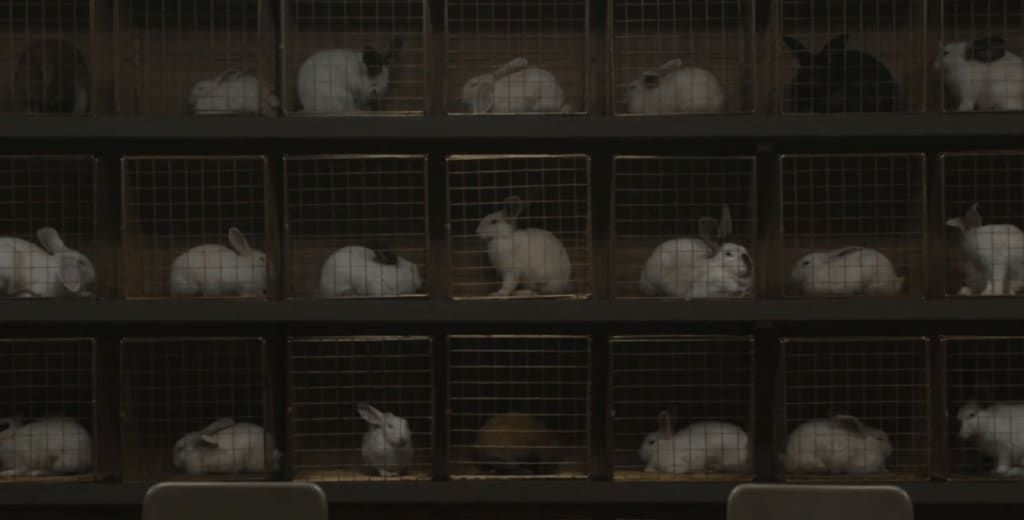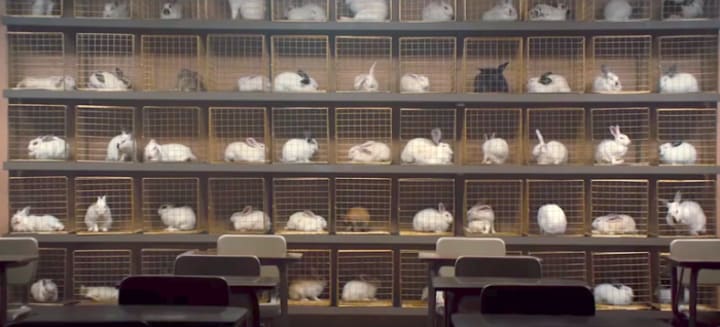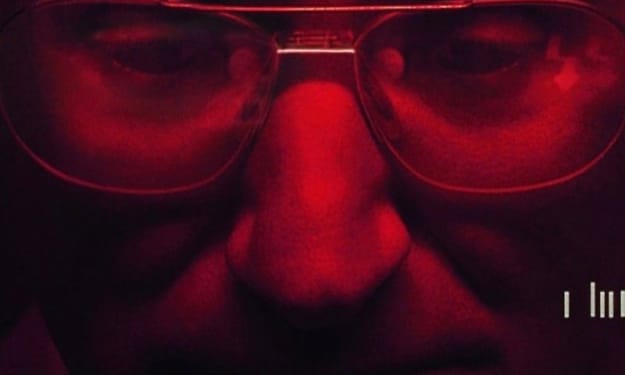A Filmmaker's Guide to Animals as Psychological Symbol
How can animals add to concept and thought to create meaning?

Cue scary/creepy violins.
This article is all about how to use animals correctly to create a concept. Now we first have to remember that not everyone knows what an animal could psychologically/implicitly stand for in terms of meaning (for example: lion = courage etc.) but most of us know it if we see the meaning being created in the film (the most obvious example being the lion from The Wizard of Oz). Animals are a great way to create meaning without having to use objects to which the camera keeps flashing back to and the audience get tired of—animals can be physically anywhere.
There are a few films we are going to look at when we see animals being used as a psychological symbol and before we state them, I am going to define what I mean by 'psychological symbol'. A psychological symbol is a symbol that isn't created through the camera continuously flashing back to it or by the characters constantly referring to it. It is almost subliminal and subconscious. It is a symbol that is really just 'there' and we, as an audience, begin to associate it with ideas and concepts littered throughout the film. Whether the ideas we associate with the animal are correct or not does not matter, the point is that we have got the gist of what the filmmaker was telling us to do: notice the animals. Notice the animals and start making associations. They aren't just 'there' anymore. They are more than there. They are everywhere. Here's how it goes:
Animal on screen > concepts and themes begin in film > animals become more frequent on screen > concepts become more developed in film > audience association begins > latter half of film > audience association is complete > the audience knows the meaning of the animal.
As a filmmaker it is your job not to be too obvious but to be obvious enough that the audience understand that it is an animal they are looking out for. I would also stick to one or two animals, after that it gets a bit confusing for the audience to keep up. Let's take a look at our films then:
- Get Out (2017)
- You're Next (2011)
- Us (2019)
Within these we are going to have a look at the following things: what the animal is, what the animal is used for and how effective is this animal as used in the film. We are also going to have a look at what you could take away from this as a filmmaker if you, in your own project, were to use animals as psychological symbol.
Get Out (2017)

Everyone knows that the animal most prevalent in the film Get Out (2017) by Jordan Peele is that of a stag. The stag with large antlers mounted on a wall as a trophy or prize, making the family look important, wealthy and polished to the other folks like them in the film. This is a very important thing to remember, we only see the stag when the theme and concept are completely established. The concept here is predator vs. prey. The stag is prey and is often mounted on a wall in order to show off to others about how wealthy someone is.
In this case as well, the stag is linked to the main character in which they have been taken in by a white family and thus, everyone else would think their morals are 'wealthy' as they have become the white saviours to this black man. They proudly mount him on their house but indirectly, they hunt him down in order to make themselves look like better people. Therefore, he is a type of stag. But the stag on the wall actually represents the reformed friend who tells him to 'get out'.
It's highly effective as a symbol because of the fact it is mounted on the wall. If it was not, the stag would be difficult to associate with a hunting party. The fact that it is mounted on the wall means that this has something to do with hunting and how hunting is associated with wealth. Therefore, it is representative of how wealthy the family are in terms of morals to their white friends when it comes to looking at the race of the man who is in love with their daughter.
The ways in which you can use a stag are somewhat more simple than the other two we're about to go through. Your main character needs to be someone who is indirectly hunted. This must be such a bad reason disguised as a good one—i.e the white saviour complex. "Look at me, I'm helping a person of colour I must be such a good person..." instead of the fact that helping people should come from the goodness of your heart regardless of race, age etc. Thus, actively hunting out these people in order to make yourselves feel better is the entire concept of the hunting party, prevalent and actually seen in the film. From then on its a programming cycle so that the hunted can think they have been saved and thus, are mounted on the wall of the white person's house.
You're Next (2011)

The movie You're Next (2011) has two or three different animal characters but, opposite to the movie previously analysed in this article—we deal here with the predatory creatures. Wolves feature frequently throughout the film, not as animals but as animalistic impulses—hence the masks. The idea is not to hide behind one's animalistic impulses and instead, show them for as they are. Thus, the predatory nature of humans to hunt is much like that of a wolf and so, the predator here wears a wolf mask.
Is it effective? Yes. Is it too obvious? Also yes. It is obvious without being over the top though. Something that was over the top would have more than one wolf item involved. Something that was over the top would involve all things 'wolf-life' and possibly some cringe-fest lycanthropy to go along with it. I wouldn't worry too much about trying to understand the intricacies of this symbol because there aren't a lot of them. Most of it just comes from the actual predatory nature of humans finally being shown through this psycho-drama style mask. The fact that it is so well-fitted as well means that it definitely fits the face of the person who is wearing it. It makes it all that tad bit creepier.
If you're going to use this in your movie then please choose an animal which is more often associated with predators than something obscure that you want the audience to figure out because it won't really work the way you planned it to. The audience need to know the connection by the time the movie's second half gets underway and so, if you choose something obscure, you're not going to have that happen. In this case, it is an obvious animal but it works and that is the most important thing here.
Us (2019)

Another one of Jordan Peele's horror films then, this time we're looking at rabbits. Rabbits feature so prevalent in the film that it is really hard to ignore the fact that they're there altogether. They are pretty much everywhere in the tethered world and they're running around wild as if nobody is there to care about them. They all pretty much look the same but then there's some that stand out from the crowd. Rabbits are used for exactly the purpose I've just been describing. There is also an instance in the film where the tethered mentions what the rabbits are actually doing there in the first place, which adds an extra layer of meaning because now, they're not just there randomly. The tethered explains that they, down in the abandoned subways, eat raw rabbit—all bloodied and cold.
Highly effective in the way it has been designed, this symbol becomes something physical because now we have a meaning from a character in which they eat it raw, and we also have this association that is taken simply from looking at and watching the rabbits. They become more and more abundant as the tethered people move above ground and no longer rely on the rabbits for food. This means we get to see them more and more of the time whilst the film goes underground and the tethered battles out with her above-ground self. But, apart from eating the rabbits raw for food there is absolutely no other mention from the characters about the rabbits—all of the rest comes from psychological understanding of concepts and themes. Thus, we have a psychological symbol in the works.
If you're looking for a symbol like this, you need something that is abundant that people can actually eat. This would allow you to have an excuse as to why they are so abundant. Another way in which you could do this is to domesticate the animals as helpers in the other world and thus, allow there to be a hierarchy system as well as a psychological symbol. It is a complex image but it is very much possible and I wish you all the best when using an animal in this way.
Conclusion
Well, that's all we've got time for today and I hope you've learnt something about how animals are used as psychological symbol. I hope that you can also understand that animals are a much better symbol to use for human concepts instead of simply objects. Animals, being alive, are more connected to humans than objects, which are not alive, are. Thanks for reading this article and good luck on your next project.
About the Creator
Annie Kapur
200K+ Reads on Vocal.
English Lecturer
🎓Literature & Writing (B.A)
🎓Film & Writing (M.A)
🎓Secondary English Education (PgDipEd) (QTS)
📍Birmingham, UK






Comments
There are no comments for this story
Be the first to respond and start the conversation.